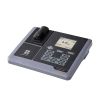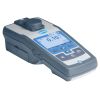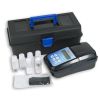Hach TL23 Series Benchtop Turbidimeters
Features
- Large full color display with guided procedures for calibration and verification
- Instrument detects sample stability prior to taking a reading
- USB port for data export, sample identification for traceability and self-diagnosis for quality assurance
- Free ground shipping
- Expedited repair and warranty service
- Lifetime technical support
- More
Overview
The Hach TL23 Series laboratory turbidimeters blend trusted technology of the 2100N/AN and improved features to simplify testing in the most demanding industrial and wastewater applications. With their ratio technology, the TL23 lab turbidimeters are ideal for industrial and other samples with a wide range of turbidity. The TL23’s ratio technology helps to overcome the interference from large particles and color when measuring turbidity.
Four Types of Models
- TL2300 (EPA, up to 4,000 NTU)
- TL2310 (ISO, up to 1,000 NTU)
- TL2350 (EPA, up to 10,000 NTU)
- TL2360 (ISO, up to 10,000 NTU)
TL2300 and TL2350 Turbidimeters
The optical system is comprised of a tungsten-filament lamp, lenses and apertures to focus the light, a 90° detector, a forward-scatter light detector, a backscatter detector (TL2350 only) and a transmitted-light detector. The instrument permits turbidity measurements at less than 40 NTU to be performed using only the 90° scattered-light detector or from 4000 NTU (TL2300) to 10000 NTU (TL2350) using the complete set of detectors (Ratio Measurement). With the Ratio Measurement on, the instrument’s microprocessor uses a mathematical calculation to ratio signals from each detector.
TL2310 Turbidimeter
The optical system includes an 860 ±30 nm light emitting diode (LED) assembly and a 90° detector to monitor scattered light. The instrument measures turbidity up to 1000 FNU or NTU using the single 90° detector. The instrument does not utilize ratio measurements.
TL2360 Turbidimeter
The optical system includes an 860 ±30 nm light emitting diode (LED) assembly and a 90° detector to monitor scattered light, a forward-scatter light detector, a transmitted-light detector and a back-scatter light detector. The instrument measures turbidity up to 1000 units in FNU measurement mode using the ratio detectors. Attenuation measurements of up to 10000 FAU units can be made using a single transmitted detector. The instrument measures turbidity at less than 1000 NTU using only the 90° scattered-light detector or up to 10000 NTU using the complete set of detectors (ratio mode).
- TL23 Series Turbidimeter
- Silicone oil
- Oiling cloth
- USEPA filter assembly
- 1-inch sample cells (30 mL) with caps (6x)
- Gelex secondary turbidity standardization kit
- StablCal calibration kit
- Power supply
- Power cord
- Dust cover
In The News
Source Water Monitoring in Albany, New York: Tracing Water Quality throughout Tributaries
Thousands of US cities pull their drinking water from natural source waters like reservoirs, rivers, and streams, making overall watershed health a key consideration for water providers. In Albany, New York, the Albany Department of Water and Water Supply delivers drinking water to over 100,000 residents as well as monitors and manages the larger drinking water supply watershed. Hannah Doherty, Environmental Specialist at the Albany Department of Water and Water Supply , spends her days working with a small team to monitor the drinking supply and the connected water bodies. Doherty explains, “We’re the first to encounter the water that ends up being the drinking water.
Read MoreWildfire Prevention in the Sierra Nevada Region with the Yuba Watershed Institute
Though recent wildfires have sparked new conversations about wildfire management and response, groups like the Yuba Watershed Institute have been monitoring the forests and water resources of the Sierra Nevada region for decades, managing approximately 5,000 acres of land with the Bureau of Land Management (BLM) and about 7,000 acres in private land partnerships. The goal of the Institute is to work with local communities and land agencies to improve watershed and forestry management through informed practices and public outreach. The goals of the Yuba Watershed Institute are three-fold: Improve the ability of fire suppression agencies like the California Department of Forestry and Fire Protection ( CAL FIRE ) and the US Forest Service.
Read MoreWave Sensors Integration with NexSens Buoys: A Cutting-Edge Solution for Wave Measurment
Real-time wave data supports accurate weather prediction, safe and efficient maritime operations, and provides valuable safety and operating condition information for recreation and commercial fishing. Understanding wave dynamics also helps with the design of protective coastal structures like seawalls, breakwaters, and jetties. It also supports better prediction of their impact on sediment transport and coastal geomorphology. Wave data is a key factor in qualifying and designing offshore wind farms and harnessing kinetic energy for electrical generation. It helps with the understanding of ocean-atmosphere interactions and contributes to studies of sea-level rise and climate change impacts.
Read More














